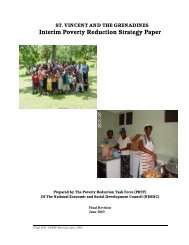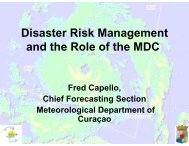The Anatomy of A Silent Crisis The Anatomy of A Silent Crisis
The Anatomy of A Silent Crisis The Anatomy of A Silent Crisis
The Anatomy of A Silent Crisis The Anatomy of A Silent Crisis
- TAGS
- anatomy
- www.bb.undp.org
You also want an ePaper? Increase the reach of your titles
YUMPU automatically turns print PDFs into web optimized ePapers that Google loves.
Conclusion<br />
Multiple responses to climate and energy policies<br />
Technology transfer for adaptation as well as clean development is also key. Energy poverty<br />
afflicts close to one third <strong>of</strong> the population <strong>of</strong> this planet, who benefit from no form <strong>of</strong> modern<br />
energy supply whatsoever — instead relying on the burning <strong>of</strong> soot and dung. This has huge<br />
ramifications for human health, triggering respiratory diseases over time, as well as carbon emissions.<br />
Providing decentralized renewable energy for the poor would be a revolution. It would lead to a<br />
rapid contribution to reducing emissions — up to 18 percent <strong>of</strong> warming being due to black carbon<br />
from soot. It would bring modern energy to places far beyond the existing grid and likely energize<br />
the Millennium Development Goals. <strong>The</strong> benefits would be <strong>of</strong> particular importance to women and<br />
children, who spend hours <strong>of</strong> their day gathering firewood, <strong>of</strong>ten at great risk, and inhaling hazardous<br />
smoke while cooking. It will also be necessary to revisit the research agenda to provide access to<br />
suitable technologies beyond wealthy countries. <strong>The</strong>re is, for instance, no reason why research<br />
undertaken in developed countries using public money could not be made accessible to everyone.<br />
Dealing with mass displacement <strong>of</strong> people<br />
If we do not act, ultimately, people will either die or they will move. Millions <strong>of</strong> people are already<br />
on the move today because <strong>of</strong> climate change. What are termed here Climate Displaced People<br />
are <strong>of</strong>ten difficult to identify down to the individual. Climate change is a generalized phenomenon. It<br />
is rare that an impact, such as a storm or a flood, can be entirely blamed on climate change. Most<br />
low-elevation territory is reclaimed through a combination <strong>of</strong> sea-level rise and ordinary geological<br />
subsidence, although climate change greatly accelerates this process. So if a cyclone hits, it would<br />
be impossible to say if one particular individual is a climate displaced person or not. This report<br />
attributes 40 percent <strong>of</strong> extreme weather-related events to climate change, based on their steady<br />
increase over the last 30 years. That itself is an average, which would vary greatly from situation<br />
to situation, if applicable at all to that specific a level. But globally we can say with some degree<br />
<strong>of</strong> confidence that around 40 percent <strong>of</strong> those displaced because <strong>of</strong> extreme weather events are<br />
in fact Climate Displaced People. We count over 26 million Climate Displaced People today. That<br />
is likely to triple by the 2020s. It does not, however, include those economic migrants who might<br />
also be attributed to climate change, since varied climate shocks can and do act as drivers <strong>of</strong> such<br />
migration. <strong>The</strong>re is little protection or assistance available under international law today for these<br />
vast numbers <strong>of</strong> people. In fact, the international community struggles with existing populations<br />
<strong>of</strong> Internally Displaced People and <strong>of</strong>ficial Refugees. Protection for Climate Displaced People<br />
is particularly weak when the crossing <strong>of</strong> national borders is involved. <strong>The</strong>y will also encounter<br />
legal lacunas, such as when a low-elevation state is entirely submerged by rising-seas. <strong>The</strong>se<br />
shortcomings will soon become crippling for the international community, given the sheer numbers <strong>of</strong><br />
people involved.<br />
81







